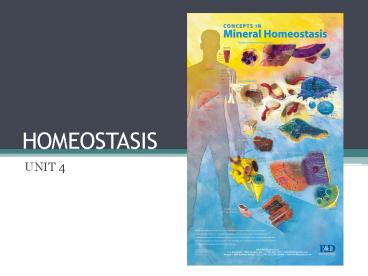HOMEOSTASIS - PowerPoint PPT Presentation
Title:
HOMEOSTASIS
Description:
HOMEOSTASIS UNIT 4 What happens in your body when you do a Triathalon? Cell Resp increases Body Temp increases to 39 degrees Celsius (due to heat from CR rxns) Sweat ... – PowerPoint PPT presentation
Number of Views:315
Avg rating:3.0/5.0
Title: HOMEOSTASIS
1
HOMEOSTASIS
- UNIT 4
2
What happens in your body when you do a
Triathalon?
- Cell Resp increases
- Body Temp increases to 39 degrees Celsius (due to
heat from CR rxns) - Sweat is produced to dissipate heat
- This loss of water, drops blood pressure
- Heart responds, Kidneys conserve water
- Electrolytes (salts) are lost in sweat
- Body must use hormones to keep a steady supply of
glucose to CR pathways - Nervous systems monitors o2 levels, increasing
breathing rate if necessary - Nervous systems also work with the circulatory
system to divert blood to essential areas
(muscles, brain, heartaway from stomach etc)
3
4km swim, 180km bike, 42km run!
4
The Ideal Body State
- 37 degrees
- 0.1 blood sugar
- Blood pH 7.35
- Environment doesnt always allow for this!
- Organs and body systems are constantly adapting
- See page 324
5
Homeostasis
- All of our organ systems work
- together to maintain Homeostasis
- Homeostasis is a steady internal
- state, keeps conditions in the body
- constant.
- Examples
- Blood Pressure (circulatory system)
- Respiration Rate (respiratory system)
- Body Temperature (circulatory system)
- Blood Sugar (digestive and circulatory)
- The brain and the adrenal system
- (hormones) do most of the
- regulating.
6
Three Components of Control
- Monitors
- (Brain stem receptors detect increased CO2 in the
blood) - Coordinating Centre
- (Nerve cells in brain receive and send a signal
to the diapragm) - Regulator
- (Diagragm increases depth and rate of breathing)
7
Dynamic Equilibrium
- There will always be fluctuations in levels
- Homeostatic mechanisms ensure that all body
systems function within an acceptable range. - Mammalian Diving Reflex (P. 340)
- Check out the ICEMAN!
- http//www.youtube.com/watch?vmadoDvtKEes
- HomeworkRead P335-336 (Feedback)
- Do Q 1-5 P. 337
- Read P338-341 Thermoregulation!
8
Feedback Mechanisms
- Negative Prevent small changes from becoming
too large (i.e. A thermostat) - Most controls in the body are negative feedback
- Positive amplify small effects (i.e. Oxytocin
and childbirth)
9
Thermoregulation
- Maintenance of body temperature within a range
that enables cells to function efficiently - Hypothalamus Region of the vertebrates brain
responsible for coordinating many nerve and
hormone functions.
10
Ecto Vs. Endo
- Ectotherms Invertebrates, fish, amphibians,
reptiles...Depend on air temp to regulate body
temp. - Endotherms Mammals Are able to maintain a
constant body temp regardless of surroundings.
11
(No Transcript)
12
Thermoregulation
Stimulus Physiological Response Adjustment
Decreased Enviro Temp -Constriction of blood vessels -Hairs stand on end -Shivering -Heat is conserved -More heat is generated by increased metabolism
Increased Enviro Temp -Dilation of blood vessels of skin -Sweating -Heat is dissipated
http//www.youtube.com/watch?veJEXdWHKDmg
http//www.youtube.com/watch?vvc86u0IsOwcfeature
related
http//www.youtube.com/watch?vYotp6ov9-w0feature
fvw































